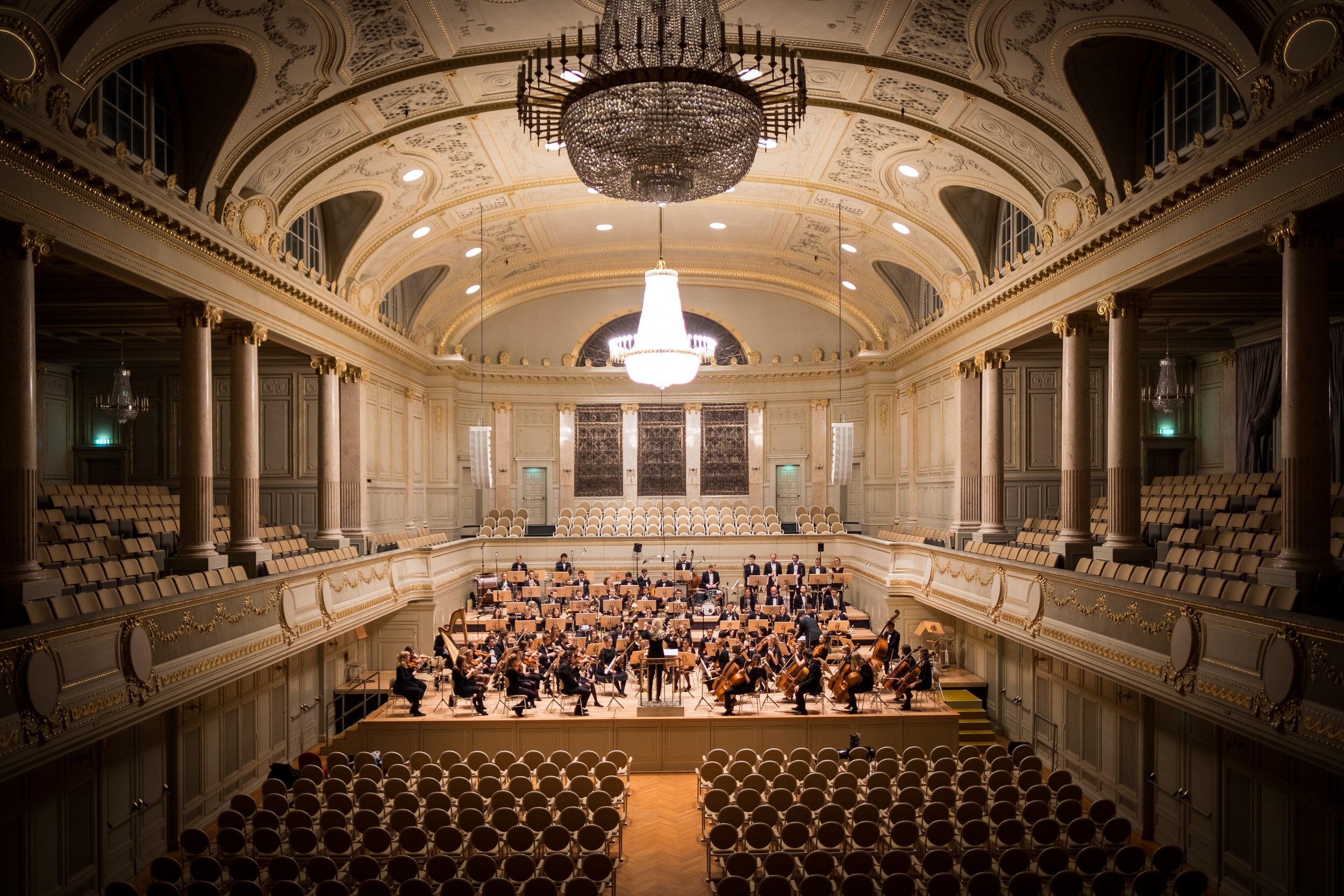What do you do? — An FAQ Symphony
Overture
After I answer “I’m a video producer + editor”, the second most common question in my professional life is 'Oh cool - What kind of video? If time and setting allow, I’ll play this video or one of these to convey the aesthetic I’ve developed.
But here’s a confession: every time I’ve ever been asked the WDYD follow up question, the babel fish lodged in my left ear flaps its tail, translating “what kind of video?” into:
“Video eh? Why, this could detail any 24 image-per-second expression of motion!
Sing me the symphony of your passion!! Are you not an artist, a communicator, a storyteller?
Make haste! Take this baton. The orchestra awaits. Conduct each movement of your soul’s vision with the care it deserves!
Being a man of reasonable emotional intelligence, I typically quell the babble-grandeur of my inner voice. I gauge the inquisitor, and tailor a glimmer of what kind of video I do to match their demeanour + how much elevator runway there is. There’s three directions I can go. Each is its own conversation. But they’re all a part of my why.
Apart from the occasional deep dive with a close friend, where the time luxuries of restaurant menus and cooling phở broth are on my side, I feel I almost always give a fragmented answer.
Here, in inaugural written form, I welcome you to a front row seat in the audience of my orchestra. There are three movements. Each one explores a problem/opportunity where I’ve sought to embody a visual solution through video.
So, without further ado:
I. The Glut
Picture the last explainer video you saw. There’s a voiceover saying “so what exactly is bitcoin?” What do the visuals look like?
Have you summoned your mental imagery?
Please do. I invested a solid 15min figuring out a reveal effect workaround of using a solid white jpeg as a custom thumbnail on the video below. Then I had to type out this preamble you’re currently reading. All so we could play an a-synchronous game together.
Ok, so here’s the game again:
A voiceover says “so what exactly is bitcoin?” What do the visuals look like?
When you’ve got the mental image, click the play button, watch a few seconds, then I’ll meet you in the next sentence.
I’ll bet 9.68/10 of you envisioned something nearly identical to that video
Bright solid colours …
… 2D animated objects morphing into one another…
… and lanky explainer-folk — the grinning utopian ideal you too can become once ___(insert BrandX)__ has been explained.
The animation and design of that bitcoin video are professional. The $10K-$15K the client probably invested shows up for a video with good pacing that’s clean + clear. The video aesthetic isn’t the problem. The problem is, BrandX typically emphasizes their dedication to diversity, innovation, and originality — through an aesthetic that embodies none of these buzzwords.
It's a strangely ubiquitous hypocrisy.
Brands wave proud banners of first principles thinking + emphasize their nuanced, human approach — within the same default template as everyone else.
Clip from Solar Sands excellent YouTube video: Why do "Corporate Art Styles" Feel Fake? (12min)
We live in a time where diversity is a focal point. So where is the diversity in informative video? Why are the full range of subjects and speakers rendered in this same look?
The startup/corporate/design agency internet can feel like a zombie movie without Will Smith. A lifeless gangly horde of explainer-folk sways from one landing page to the next. You need only hear the coy trill of their royalty-free xylophones on the horizon to know they’re coming. Soon dancing geometric shapes + squiggles will be clarifying your mortgage options.
Of course there are beautiful classic-style animated explainers, hybrid craft outliers, and visionary exceptions that transcend mortal description. But just think how unnaturally sterile it’d feel if up until now almost every music video was animated.
Perhaps a master animator could conjure a roller-blading fever dream or inception growing pains, and produce a music video that evokes these same emotions. I doubt it. Some story worlds are only possible within the textures of reality.
II: Invisible Audio
Audio has no inherent grip to display itself on the internet’s visual landscape. Our timelines are optimized for photos and videos, not audio. And right now, we are seeing the biggest ever increase in audio worth sharing. Audiobooks have exploded from the dusty archives of library cassette sections, to now occupy a huge earshare. Podcasts are common enough to be an icebreaker on dating profiles.
Audio is lucrative too. The podcast production company Gimlet sold to Spotify for $230 million after only 4.5 years. Jacob Weisberg, CEO and co-founder of industry leader Pushkin Industries said “The moment reminds me of the early days of the Internet because of the scale of both the creative and commercial opportunity”.
Podcast listeners are an advertiser's dream: young, well educated + upper middle class. According to Midroll’s data, podcast listeners make it through about 90% of a given episode. Relatively few skip ads. I can attest that at a certain tipping point of Tim Ferriss and Lex Fridman endorsements, I too started drinking Athletic Greens.
So where are the podcast trailers? I’ve seen and made a few, but it surprises me how rare they are. At this point, I’ve got hundreds of saved episodes competing for my thumb on the play button in Overcast. If a new show wants to find me online and jump the queue to tomorrow’s breakfast prep, it’s gonna have to stand apart.
Same goes for audiobooks. I’d love to see authors and publishers embrace producing their own YouTube canon to build + enrich the launch. Soon that’ll be standard for an entrepreneur/author/podcaster/course creator/thought leader with a thriving business. They’ll invest in a series of 3-6 videos that explores the core concepts of their new project visually.
This can go beyond convenience video audiograms to fully immersive narratives. We can already see this unevenly distributed future through Netflix and Bill Gates choosing to invest in a canon version of their own work + values on YouTube, rather than leave them open to someone else’s visual interpretation.
It’s great if someone is eager to speak on-camera for part of a video. But if they’re camera shy or busy there’s no need to sit in front of a camera to ‘develop an audience’ with video. They already have the audience. If words are well expressed in audio, they are one dimension away from shareable video. Using pre-existing audio as a starting point, you retain the personal voice, + message but remove the hassle of appearing on camera to speak
We are all visual learners. Some of us also become proficient in dealing with text as a visual abstraction. But I often wonder how sizable an audience is lost to ideas that only exist in written form.
III: Content Density
Social media has raised our collective visual literacy. Easier access and affordable tools have granted us all the eyes of amateur photographers, designers and editors. But as the audience gets better at seeing the illusion, a lot of magicians are repeating the same old vaudeville.
One of my biggest pet peeves are videos where the imagery is a literal representation of the voiceover: we hear about studying and see a shot of ….someone with papers at a desk. Then they talk about money, and we see a shot of hands shuffling currency. Curiosity is pattern matching. Once we can predict the pattern / figure out the template, attention glaze sets in.
Whenever there’s a voiceover, visuals should provide a countermelody. Think of the song pachelbel canon, that classical stringed bop they often layer in as people enter a formal setting. Each new instrument doesn’t just repeat the same initial melody. They weave together a series of harmonies.
The worst reason to develop an idea visually is video is the content that goes in the YouTube bucket. Generic stock footage makes me disengage, regardless of the information being shared. I’d rather eliminate the visual filler. Give me the raw information as a blog post I can read at my own pace. Send me a podcast I can listen to as I unload the dishwasher. This is why we love TikTok. It provides a steady state of content density. No filler. Pure meme brilliance calibrated to your taste.
If someone watches your video at 2x speed, perhaps you're successfully relaying data, but you have failed at making a video. You don’t need to speed up a beautiful painting. The single image contains depth that seduces your curiosity towards further inquiry.
All of us are bombarded with more stimulus competing for clicks than we'd like. If we care about the friends + families in our audience the best way to maintain that trust is sharing meaningful work. As the title of Tony Zhou’s legendary channel Every Frame A Painting highlights, the video should be about looking deeper. Once you've built an audience that's of great value to you — reciprocate. Value their time with visual depth.
Most online videos force a choice between visual or informational depth. It’s rare to find both the insight of a TED Talk and creative energy of a music video. My aesthetic is designed as a direct contrast to the internet’s glut of animated explainers. I wanted to see video with the realism + relatability of live action storytelling AND the freedom of analogy + form you get in animation.
Finale
What do YOU do? Many of us focus too much on the wrong part of that question. Obsessed with our ‘you’, more than our doing. An insight from Derek Sivers I try to remember is that we need more bold followers. There’s a lot of great leaders already. One of the best ways to actualize an audacious vision of the future is to put your own formidable weight behind a leader you believe in.
There are moments where the challenges of the coming decade shoot high voltage adrenaline + cortisol into my veins. I want to pivot from video. Become an engineer. Go help spearhead sustainable infrastructure. Save the future. Make Elon proud.
Once the urgency simmers, I remind myself how essential storytelling is to leaders worth following. Ideas are doomed to perish on visual platforms without compelling visuals. If I can assist in the filter function of the internet by spotlighting and amplifying the best ideas, that’s a powerful visual handprint.
👉 If you enjoyed this post, here’s a link to my Twitter where I continue to explore these ideas in public.


